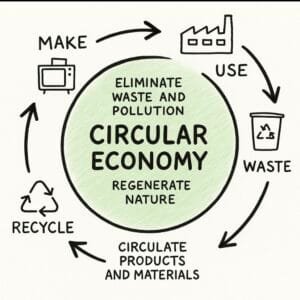The Circular Economy- Ending the Throwaway Culture

Imagine a world where your old smartphone doesn’t end up gathering dust in a drawer or, worse, polluting a landfill. Instead, it’s refurbished, reused, or its parts are recycled to create something new. Welcome to the circular economy—a transformative approach to production and consumption that’s gaining momentum worldwide.
From Linear to Circular
Traditionally, our economy has followed a linear model: take resources, make products, and dispose of them after use. This “take-make-waste” approach has led to environmental degradation, resource depletion, and mounting waste.
The circular economy emphasizes three core principles:
- Eliminate Waste and Pollution: Design products and systems that prevent waste and environmental harm from the outset.
- Circulate Products and Materials: Keep items in use through reuse, repair, refurbishment, and recycling, maintaining their value for as long as possible.
- Regenerate Nature: Support natural systems by returning valuable nutrients to the soil and fostering biodiversity.
Why It Matters
Adopting a circular economy is good for the planet, and it’s a smart economic move. Research indicates that circular strategies could unlock $4.5 trillion in economic growth by 2030.
Moreover, reducing our reliance on non-renewable resources and minimizing waste, we can reduce climate change, protect ecosystems, and build more resilient communities.
Real-World Applications
- Fashion Industry: Brands are embracing sustainable practices by designing clothes for longevity, offering repair services, and recycling textiles into new garments.
- Electronics: Companies are creating modular devices that are easier to repair and upgrade, extending their lifespan and reducing electronic waste.
- Right to Repair Legislation: Governments in the U.S. and Canada are increasingly supporting the right to repair, ensuring that consumers can access the tools and parts needed to fix their devices. This movement is essential for extending the life of electronics and reducing e-waste.
- Modular Design: Companies like Fairphone and Framework are leading the way in creating smartphones and laptops that are easily repairable. These devices are designed with replaceable components, allowing users to fix or upgrade parts without needing to replace the entire product.
- Recycling Programs: Tech giants like Apple and Dell have launched recycling programs for old devices. These programs aim to recover valuable materials, such as rare earth metals, and reintegrate them into new products.
- Food Systems: Initiatives are underway to compost organic waste and turn it into valuable fertilizer. Another initiative to design packaging that’s biodegradable or reusable.
Your Role in the Circular Economy
Every individual can contribute to this sustainable shift:
- Choose Durable Products: Opt for items designed to last, and support brands that make a priority of sustainability.
- Embrace Sharing and Renting: Consider sharing tools, vehicles, or other infrequently used items, reducing the need for new products.
- Support Right to Repair: Get involved in advocacy efforts by supporting organizations that push for stronger right-to-repair laws. This will help ensure that everyone has the opportunity to fix their electronics instead of replacing them.
- Recycle and Compost: Properly sort waste to ensure materials are recycled or composted, keeping them out of landfills.
- Buy Second-Hand: Consider purchasing refurbished electronics. Not only is this often more cost-effective, but it also reduces the demand for new devices and supports the circular economy.
- Educate Yourself and Others: Spread awareness about the circular economy and the importance of sustainable practices in electronics. The more people understand, the more collective action we can take.
Looking Ahead
Transitioning to a circular economy requires governments to work with businesses and consumers. And make policies that include incentives for sustainable practices, investments in circular infrastructure, and public awareness.
The Electronics Sector and Circular Economy
Electronics are a significant focus within the circular economy due to their rapid turnover and the environmental impact of e-waste. Several initiatives are underway to address these challenges:
- Right to Repair Legislation: Governments in the U.S. and Canada are increasingly supporting the right to repair, ensuring that consumers can access the tools and parts needed to fix their devices. This movement is essential for extending the life of electronics and reducing e-waste.
- Modular Design: Companies like Fairphone and Framework are leading the way in creating smartphones and laptops that are easily repairable. These devices are designed with replaceable components, allowing users to fix or upgrade parts without needing to replace the entire product.
- Recycling Programs: Tech giants like Apple and Dell have launched recycling programs to take back old devices. These programs aim to recover valuable materials, such as rare earth metals, and reintegrate them into the production of new products.
